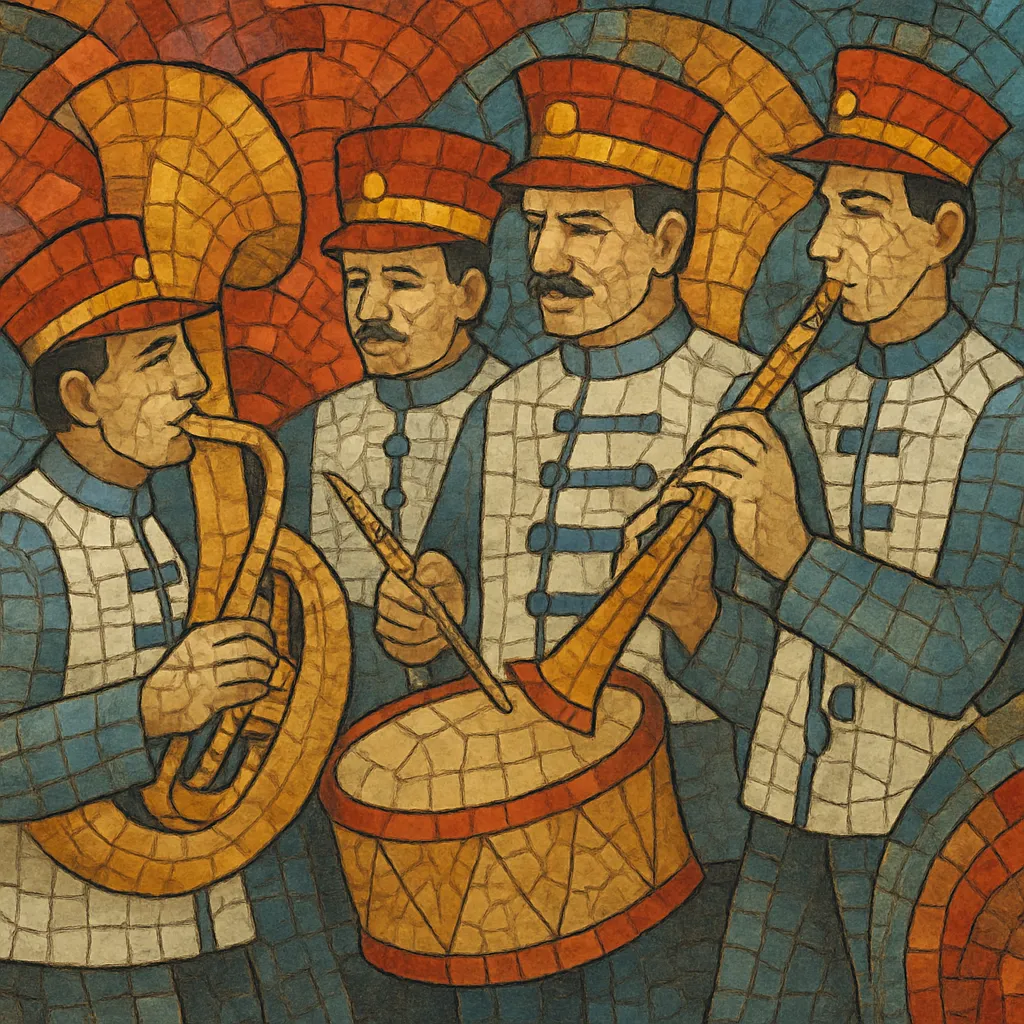Bandinha is a Brazilian small-ensemble brass and reed style rooted in Central European "oom-pah" traditions and local dance-band practice.
It is typically performed by compact groups featuring trumpet, clarinet, trombone, euphonium or tuba, accordion, and a light marching-style percussion battery (snare, bass drum, cymbals). The repertoire centers on polkas, waltzes, schottisches (xotes), and marches, adapted to Brazilian festive contexts such as municipal celebrations, church kermesses, and Oktoberfest-style events in the country’s southern states.
While closely related to German, Austrian, and Czech village-band idioms, Bandinha emphasizes a dance-forward groove, bright unison melodies, and accessible I–IV–V harmonic movement, often colored by Brazilian phrasing and regional humor. Its sound is cheerful, communal, and highly portable, designed to animate street parades, tents, and dance floors alike.
Bandinha emerged in southern Brazil in the early 20th century, as waves of German-speaking and other Central European immigrants (19th–early 20th century) brought village brass-band traditions to states like Santa Catarina, Rio Grande do Sul, and Paraná. Community societies and church-linked ensembles adopted polkas, marches, waltzes, and schottisches, gradually hybridizing them with local dance culture.
By the 1900s–mid-century, small brass-and-reed formations—lighter and more mobile than full town bands—coalesced into what locals affectionately called "bandinha" (little band). The core "oom-pah" rhythm, clarinet/trumpet melody leads, and accordion accompaniment became hallmarks. Repertoires expanded to include humorous songs, call-and-response crowd parts, and Portuguese lyrics, while maintaining Central European forms and keys suited for wind instruments.
Post–World War II municipal festivals, beer halls, and later Brazil’s Oktoberfest circuits (notably in Blumenau and surrounding cities) amplified Bandinha’s visibility. Uniformed groups entertained in tents and parades, keeping tempos danceable and arrangements concise. Radio, records, and regional baile circuits disseminated the sound across the South.
Today, Bandinha remains a staple at regional festivals, community events, and Oktoberfest-inspired celebrations. Ensembles preserve classic polkas and waltzes, while updating setlists with popular tunes arranged in the Bandinha idiom. The style continues to serve as a bridge between immigrant heritage and Brazilian festivity, and it has colored related southern dance genres and baile repertoires.
Use a compact, mobile lineup: trumpet(s), clarinet (or sax/clarinet double), trombone, euphonium and/or tuba for bass, accordion for harmony/rhythm fill, and a light drum battery (snare, bass drum, cymbals). Keep amplification minimal; the sound should project acoustically and remain street/parade-ready.
Base the feel on "oom-pah" patterns. For polka (2/4), articulate a steady bass on beats with off-beat chords; for waltz (3/4), emphasize beat 1 with supportive sway on 2–3; for schottische/xote (4/4), use a bouncy two-step with occasional syncopations. Typical live tempos: polka 120–130 BPM, march 110–120 BPM, waltz 60–80 BPM (dotted half = 60–80).
Favor diatonic I–IV–V progressions with secondary dominants and occasional borrowed chords for color. Modulate up a whole-step or half-step between strains to lift energy. Write melodies in bright, singable ranges for trumpet and clarinet, often in unison/octaves, then harmonize in 3rds/6ths for refrains.
Use short strains (A–A–B–B) with clear intros, interludes, and codas. Insert fanfares or drum fills to cue transitions. Keep textures uncluttered: low brass (tuba/euph) anchors the "oom," accordion and trombone supply the "pah," while trumpet/clarinet carry the tune. Add crowd cues (shouts, claps) to heighten participation.
Choose wind-friendly keys (B♭, E♭, F). Balance dynamics so melody sits forward without overpowering the dance pulse. Emphasize crisp articulations (staccato/polka tonguing), tight stops, and uniform phrasing. Rehearse walking/parade formations to maintain groove while moving.
Mix traditional polkas, waltzes, and schottisches with locally known songs re-arranged in Bandinha style. Include festival favorites and novelty numbers with call-and-response to keep sets lively.


